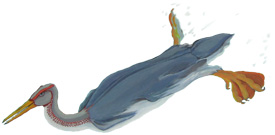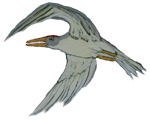
FossilsSwimming Reptiles: Mosasaurs / Plesiosaurs / Turtles Flying Reptiles: Pteranodons Bony Fish: Xiphactinus / Gillicus / Saurodon / Pentanogmius / Pachyrhizodus / Cimolichthys / Apsopelix / Enchodus / Ichthyodectes / Protosphyraena Sharks: Cretoxyrhina / Squalicorax / Ptychodus / Rhinobatos Invertebrates Crinoids: Uintacrinus Clams & Oysters: Inoceramus / Rudistes / Ostrea congesta Cephalopods: Spinaptychus & Rugaptychus / Niobrarateuthis bonneri Birds: Hesperornis / Ichthyornis Other Niobrara fossils: Coprolites / Fossil Tree Other Resources: Geology of Western Kansas / Bonner Fossil Hunters / Oceans of Kansas (off-site) Probably the rarest vertebrate fossils found in the Smoky Hill chalk are birds. They were first found in the 1870’s by Professor Mudge of Kansas State as well as the Yale Paleontogical expedition. The discoveries of two types of birds with conical teeth, set in grooves in the jaws, caused quite a stir in the scientific community. This discovery, showing the evolution of bird anatomy, gave strong credibility to Darwin’s theory. In 1880, Professor O.C. Marsh of Yale published the definitive book on toothed birds. Two main genera were described at that time: Hesperornis and Ichthyornis. Hesperornis
|


